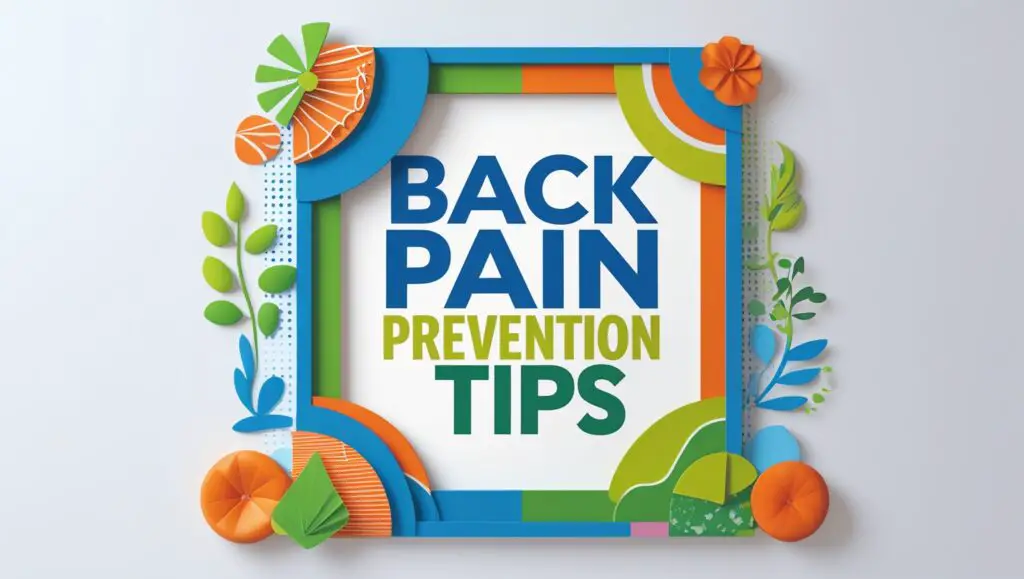Back pain is one of the most frequent health problems across the globe, affecting people of all ages and lifestyles. Whether it arises from bad posture, prolonged sitting, lifting inappropriately, or stress, back discomfort can substantially interrupt daily life. Fortunately, many cases can be avoided with modest lifestyle improvements. In this post, we discuss the best back pain prevention tips proven by science and experience, helping you keep a strong, healthy spine for years to come.

Understanding Back Pain
Back pain can be acute (short-term) or chronic (long-lasting), and it often affects the lower back (lumbar region). The pain might range from minor discomfort to excruciating stiffness or violent spasms. Common causes include:
- Poor posture while sitting or standing * Sedentary lifestyle * Improper lifting techniques * Weak core muscles * Obesity or being overweight * Stress or lack of sleep Prevention is crucial, as chronic back pain can lead to decreased mobility, loss of productivity, and even mental health issues like sadness or anxiety.
Maintain Proper Posture
Poor posture is a common cause of back discomfort, especially in the digital age where we spend hours slumped over computers and smartphones.
Tips to improve posture:
- Keep your shoulders relaxed and back straight. * Align ears with shoulders whether sitting or standing. * Avoid slouching or leaning forward excessively.
- Use ergonomic chairs that support your lower back. If you work at a desk, ensure your monitor is eye-level and your feet rest flat on the floor. Small modifications can make a significant effect.
Stay Active and Stretch Regularly
A sedentary lifestyle weakens muscles and stiffens joints, resulting to back pain. Regular movement is essential to keep your spine flexible and strong.
Try the following activities:
- Brisk walking * Swimming * Yoga or Pilates * Light stretching in the morning and evening Focus on exercises that develop your core, as these muscles support your spine and assist maintain balance. Strong abs help prevent tension on your back during daily motions.
Lift Objects Correctly
Improper lifting is a primary cause of abrupt back injury. Whether it’s groceries, a box, or a child, always use the appropriate method.
Proper lifting technique:
- Bend your knees, not your back.
- Keep the thing close to your body.
- Lift using your legs, not your waist.
- Avoid twisting your body while lifting. If something feels too heavy, don’t risk it—ask for help or use lifting tools like trolleys or straps.

. Sleep Smart
The way you sleep affects your spine’s alignment. Sleeping on an unsupportive mattress or in an awkward position might strain your back.
Back-friendly sleep tips:
- Use a medium-firm mattress that maintains your natural spine curve.
- Sleep on your back or side, not your stomach.
- Place a pillow under your knees (if on your back) or between your knees (if on your side) to decrease pressure.
- Choose a supportive cushion to maintain neck alignment.
Watch Your Weight
Carrying extra weight, especially around your abdomen, puts extra strain on your spine and back muscles. Healthy weight management through balanced food and regular exercise can considerably lower back pain risk.
Focus on nutritious meals like vegetables, fruits, lean proteins, and whole grains while minimizing processed sweets and saturated fats.
Manage Stress Effectively
Stress doesn’t just influence your mind—it also produces muscle tension, especially in your shoulders and lower back. Chronic stress can make your body rigid and increase susceptibility to pain.
Effective stress-relief techniques:
- Deep breathing and meditation * Listening to music * Gentle yoga or tai chi * Spending time outdoors * Journaling or talking to someone you trust Keeping stress in check not only improves your back but also promotes your entire health.
Avoid Prolonged Sitting
Long hours at a desk or in front of a screen can contribute to back discomfort. The trick is to move often and avoid staying in the same posture for too long.
Movement advice for desk workers:
- Stand up and stretch every 30-60 minutes. * Use a standing desk if available. * Walk during phone calls.
- Try desk workouts or chair yoga. Every little of mobility helps rejuvenate the spine and avoid stiffness.

. Wear Supportive Footwear
Your feet constitute the foundation of your posture. Wearing unsupportive shoes, like high heels or flip-flops, can misalign your spine and cause back problems over time.
Opt for footwear that offers:
- Proper arch support * Cushioning * Stability * A snug but comfortable fit If you have foot or gait concerns, visit a podiatrist for custom orthotics.
Conclusion
Back pain can be frustrating and limiting, but it’s often preventable with mindful habits. By maintaining excellent posture, staying active, controlling stress, and making modest daily modifications, you may keep your spine healthy and lower your chance of back issues.



